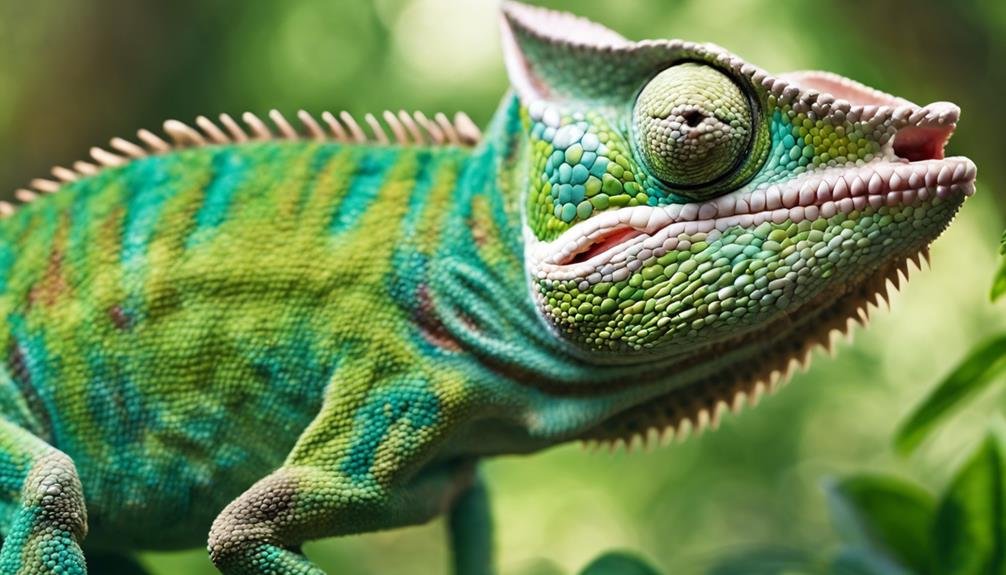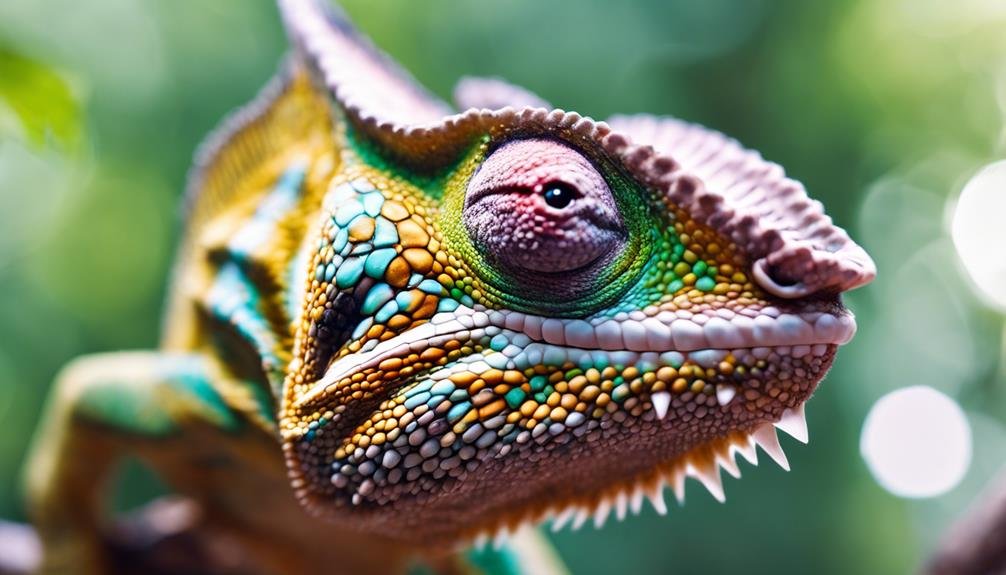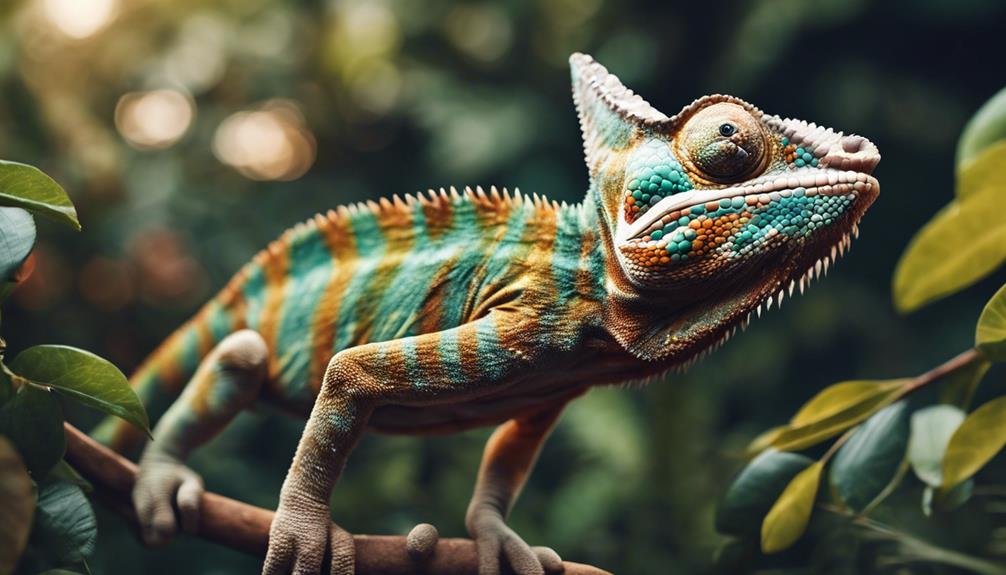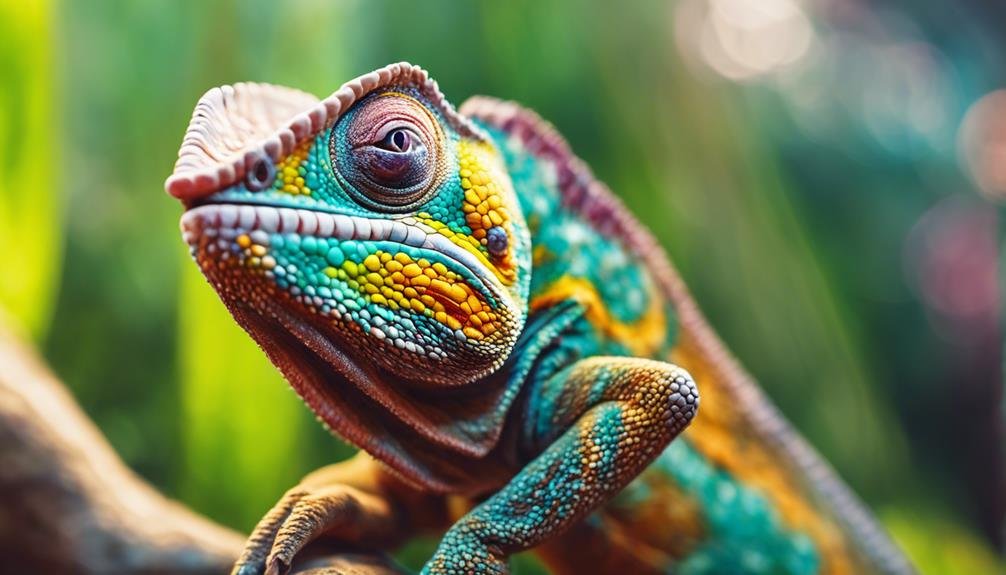You might wonder about the dental anatomy of chameleons and whether these color-shifting reptiles have teeth. Indeed, chameleons possess a unique set of teeth designed to efficiently capture and consume their prey. Their dental structure, unlike many other reptiles, plays a vital role in their hunting strategy and overall survival in the wild. But there's more to their teeth than meets the eye, including how they maintain them and the evolutionary journey that has led to their current dental configuration. To fully appreciate the intricacies of chameleon dentition and its significance, let's explore the fascinating details that underscore their survival and adaptation strategies.
Key Takeaways
- Chameleons possess a unique dental structure with teeth fused along the upper and lower jaws.
- Their teeth are sharp and permanently fixed, allowing for efficient gripping and tearing of prey.
- The continuous dental ridge in chameleons is crucial for delivering a powerful bite for hunting and feeding.
- A calcium-rich diet is essential for maintaining the health of chameleons' teeth and dental ridge.
- Dental health and the specialized structure of chameleons' teeth are vital for their survival and hunting efficiency.
Chameleon Teeth Overview
Chameleons possess a distinctive dental ridge with fused teeth that effectively grips and holds prey, playing an essential role in their survival. Unlike other reptiles with individual teeth, chameleons have developed a unique dental setup where their teeth are part of a continuous ridge along their jaw. This adaptation allows them to deliver a powerful bite, important for securing their meals. You might wonder how this impacts their daily life. Well, their jaw and teeth configuration isn't just for show; it's a critical adaptation for hunting and feeding in the wild.
Maintaining this dental ridge is essential for a chameleon's health and hunting efficiency. Over time, the ridge can wear down, which is why proper dental care is necessary for these colorful creatures. Their teeth are more than just tools for eating; they're an integral part of their survival strategy. The way chameleons' teeth and jaw work together demonstrates their unique adaptation to their environments and hunting behaviors. So, when you think about chameleon teeth, remember, they're a key feature that supports their survival in the wild.
Unique Dental Features
As you explore the world of chameleons, you'll find their dental structure isn't only essential but crucial for their survival.
Their specialized dental ridge, varying across species, plays a key role in how they grip and consume prey.
Understanding the importance of dental health in chameleons, including the need for calcium-rich diets, sheds light on how to maintain their well-being effectively.
Chameleon Teeth Structure
One of the most fascinating adaptations you'll find in the animal kingdom involves the unique dental structure of chameleons, featuring a specialized dental ridge for effective prey capture. Unlike other reptiles, chameleons have teeth that are not separate entities but are fused together along both their upper and lower jaw. This formation allows them to grip and hold onto prey with remarkable efficiency.
Here's a quick glance at their dental architecture:
| Feature | Description |
|---|---|
| Upper Jaw | Fused dental ridge |
| Lower Jaw | Fused dental ridge |
| Prey Capture | Enhanced grip |
| Bite | Powerful |
| Diet Importance | Calcium-rich for health |
This specialized dental setup is essential for their survival, enabling chameleons to thrive in their natural habitats by mastering the art of predation.
Dental Health Importance
Understanding the specialized dental structure of chameleons leads us to the importance of their dental health for effective prey capture and overall survival. These reptiles, known for their ability to change colors and blend into their surroundings, rely on a unique dental ridge that's part of the jaw. This adaptation, important for gripping and catching prey, reflects their specialized feeding behavior.
To maintain this ridge, which can wear down over time, chameleons need proper dental care, including a varied and calcium-rich diet. This not only supports the health of their teeth but also promotes their body length and overall well-being. Without healthy teeth, a chameleon's ability to hunt and feed effectively in their natural habitat is compromised, highlighting the significant role dental health plays in their survival.
Variations Across Species
Chameleons' teeth, varying from one species to another, showcase unique dental features essential for their survival. Their dental diversity is a proof of species adaptations and feeding behaviors that have evolved over time. Each species boasts a dental setup finely tuned to its diet and hunting methods, making their teeth not just tools, but survival mechanisms tailored to their environment.
| Species Feature | Dental Adaptation |
|---|---|
| Specialized ridge | For gripping prey |
| Prominent teeth | Adapted to diet |
| Structural uniqueness | Essential for survival |
| Variation in teeth size | Between males and females |
| Role in species identification | As specialized as color-changing |
This table highlights the remarkable variety and functionality of chameleons' teeth, underscoring their significance beyond mere eating instruments to important roles in ecological adaptation and species differentiation.
Tooth Development Process
You'll find chameleons' tooth development fascinating, starting from its early stages.
Unlike other reptiles, they don't go through a tooth replacement cycle, which means their teeth are with them for life.
This vital aspect is essential for their survival and effective feeding strategies.
Early Stages Formation
In their early stages, chameleons develop teeth that form along their jawbones, initiating a sequence that leads to the attachment of these teeth to the jaw. This process showcases a fascinating journey from tooth initiation to jawbone attachment, ensuring that each tooth securely anchors in place.
As young chameleons grow, they exhibit a heterodont dentition, characterized by specialized shapes that cater to their diverse dietary needs. These specialized shapes are essential for their survival, allowing them to efficiently process a variety of foods.
Researchers explore this intricate development using techniques like the TUNEL method and haematoxylin staining, focusing on the dental lamina. This approach reveals the dynamic nature of tooth development in chameleons, highlighting the complexity of their early dental formation.
Tooth Replacement Cycle
Understanding the tooth replacement cycle, it's critical to note that chameleons don't undergo this process, exhibiting a monophyodont dentition unique to their species. Unlike other animals with regenerative abilities that allow for continuous dental growth patterns, chameleons' teeth are a one-time deal. Their acrodont attachment means once a tooth is gone, it's gone for good.
| Feature | Chameleons | Other Animals |
|---|---|---|
| Dentition Type | Monophyodont | Polyphyodont |
| Attachment | Acrodont | Thecodont |
| Replacement Cycle | None | Continuous |
This unique trait highlights the importance of understanding how chameleons' dental features contrast sharply with other species, illuminating the diversity in nature's design of tooth development and replacement cycles.
Monophyodont Nature Explored


Exploring the monophyodont nature of chameleons reveals that they possess a single set of teeth throughout their lifetime, underscoring the need for diligent dental care. Unlike many other reptiles that exhibit polyphyodont characteristics, where teeth continuously grow or are replaced, chameleons don't have this luxury. Their dental growth patterns are set from a young age, with no tooth regeneration process to rely on if damage occurs. This unique aspect of their biology makes understanding and maintaining their dental health essential.
When you compare chameleon dentition to that of other reptiles, you'll notice significant differences. Many reptiles, like sharks and some snake species, have the ability to replace their teeth multiple times throughout their lives. This capacity for tooth regeneration helps these animals maintain their effectiveness in capturing and processing food. However, chameleons, with their monophyodont dentition, must rely on the single set of teeth they develop early on. This fact emphasizes the importance of providing them with appropriate care to prevent dental issues that could impact their health and feeding capabilities. Understanding their unique dental structure is key to ensuring your chameleon remains healthy and happy.
Research Techniques Employed
To investigate the unique dental characteristics of Veiled Chameleons, researchers sourced specimens from private breeders and Prague Zoo. This approach provided a thorough view of tooth morphology and embryonic development in these fascinating monophyodont species. Here's how they explored the research:
- Specimen Collection: Forty embryos, one juvenile, and one adult Veiled Chameleon were carefully selected for the study. This varied group allowed researchers to extensively examine the stages of tooth development.
- Incubation Process: Eggs underwent a meticulous incubation at 25–28°C for about six months. This period was essential for simulating natural conditions and ensuring the embryos developed properly for later examination.
- Euthanization and Fixation: Utilizing MS222 for euthanization and then fixing the specimens in 4% PFA, the researchers prepared the embryos for detailed analysis. This step was important for preserving the tissues in their most natural state.
- Analysis Focus: The primary aim was to shed light on how teeth develop in Veiled Chameleons. By focusing on the embryonic stage up to adulthood, the study provided valuable insights into the unique dental patterns of these creatures without overlapping into the nuances of reptilian dentition discussed later.
Insights Into Reptilian Dentition


Now, let's focus on the specialized teeth of chameleons, a distinctive aspect of their dentition that plays a key role in their survival. Unlike other reptiles, chameleons have a unique set of teeth, arranged along dental ridges in their jaws. This setup is a result of tooth evolution, tailored to their specific needs.
Their teeth, which aren't replaced throughout their lives, form a permanent dental structure. This permanence is unusual in the reptile world and highlights the unique path of reptile dentition evolution chameleons have taken. These teeth are sharp and perfectly adapted for gripping and holding onto prey, a critical predatory adaptation. The design of their teeth allows them to tear apart their food efficiently, making the most of each catch.
Chameleon teeth are more than just tools for eating; they're integral to their hunting, feeding, and overall survival strategies. The way these reptiles' teeth have evolved to meet their dietary needs is a fascinating glimpse into the complexities of predatory adaptations in the animal kingdom. Understanding the role of chameleon teeth offers insights into the broader topic of reptile dentition and its various adaptations across species.
Dental Care for Chameleons
Just like you take care of your teeth, chameleons also need proper dental maintenance to make sure their unique dental structures stay healthy and functional. Ensuring their dental health not only prevents dental infections but also supports their overall well-being and their ability to eat effectively.
Here's how you can maintain your chameleon's dental hygiene through their diet and preventive care:
- Offer a Varied Diet: Including calcium-rich foods in your chameleon's diet is important. Calcium intake is essential for maintaining the health of their dental ridge, preventing wear and tear.
- Ensure Proper Calcium Intake: Beyond just any food, focus on those that boost dental ridge maintenance. This might include gut-loaded insects or calcium supplements specifically designed for reptiles.
- Regular Check-ups: Just as you'd visit the dentist, your chameleon needs regular check-ups too. This preventive care is key to spotting any potential issues early on, like dental infections.
- Understand Their Needs: Each chameleon might've slightly different requirements based on their age, size, and health condition. Tailoring their care ensures they get exactly what they need for excellent dental health.
Evolutionary Significance


Understanding the evolutionary significance of chameleons' teeth reveals how these adaptations have been key to their survival and success in the wild. Their specialized dental ridge, not just any ordinary feature, plays a pivotal role in gripping and catching prey efficiently. This unique setup is a testament to the evolutionary advantages that have allowed chameleons to thrive in diverse habitats.
Chameleons' dental adaptations are a clear example of evolution crafting survival strategies perfectly suited to their needs. Their teeth, important for hunting and feeding behaviors, underscore how specific physical traits can be essential for an animal's overall well-being in the face of environmental challenges.
Here's a quick overview of how chameleon teeth contribute to their survival:
| Feature | Function | Evolutionary Advantage |
|---|---|---|
| Specialized dental ridge | Aids in gripping prey | Enhances hunting efficiency |
| Unique dental structure | Adapted for specific habitats | Increases survival chances |
| Essential for feeding | Supports hunting and feeding behaviors | Ensures nutritional well-being |
These dental adaptations signify more than just survival tactics; they're evolutionary hallmarks that highlight the importance of chameleons' teeth in their success across various ecosystems.
Do Chameleons’ Teeth and Ears Serve Similar Functions in Their Survival?
Chameleons’ teeth and ears play different roles in their survival. While their teeth are used for capturing prey, their auditory capabilities are crucial for detecting predators and other chameleons. The chameleons’ auditory capabilities allow them to sense environmental cues and communicate with one another, contributing to their overall survival.
Frequently Asked Questions
Do Chameleons Have Teeth?
Yes, chameleons do have teeth, but they're not like yours. They've got a special dental ridge for gripping prey tightly. Their bite is surprisingly strong, helping them munch on a varied calcium-rich diet essential for their dental health.
Don't let color-changing myths fool you; their teeth play a big part in their survival, adapting to their habitat preferences. So, keeping their chompers healthy is vital for their well-being.
What You Need to Know About Chameleons?
You need to know that chameleons are fascinating creatures with color-changing skin, allowing them to blend into their surroundings.
They thrive in tree habitats, using their unique feet to grip branches securely.
Their diet primarily consists of insects, which they catch with their long, sticky tongues.
Understanding these aspects of their biology helps appreciate how they've adapted to their environment, showcasing their incredible survival skills.
Does a Chameleon Bite Hurt?
Yes, a chameleon bite can hurt due to their strong jaws and a specialized dental ridge. When handling them, it's crucial to know their aggression triggers to avoid bites. If bitten, prompt bite treatment should follow to prevent infection.
Always take handling precautions to minimize stress for both you and the chameleon, reducing the likelihood of being bitten. Understanding these factors can help maintain a safe interaction with these fascinating creatures.
Do Chameleons Have Jaws?
Yes, chameleons do have jaws. Their jaw structure is quite specialized, featuring a dental ridge instead of traditional teeth. This adaptation helps them grip and capture prey effectively.
The muscle strength in their jaws allows for powerful bites, essential for their feeding habits. Understanding their jaw structure gives insight into how they catch and consume their prey, highlighting the importance of their unique dental setup in their natural diet and behavior.
Conclusion
So, now you've got the lowdown on chameleon teeth. They're not just any teeth – they're a marvel of evolution, perfectly molded for their hunting lifestyle.
Remember, these creatures sport a unique dental ridge instead of individual choppers, making their bite formidable. It's important to keep their diet calcium-rich to maintain that impressive dental structure.
Understanding their tooth development and care highlights the intricate adaptations these reptiles have made to thrive.
So, keep this fascinating aspect of chameleons in mind; it's a proof of their survival prowess.


